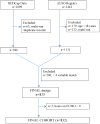The Incidence of Acute Kidney Injury and Its Effect on Neonatal and Pediatric Extracorporeal Membrane Oxygenation Outcomes: A Multicenter Report From the Kidney Intervention During Extracorporeal Membrane Oxygenation Study Group
- PMID: 27755398
- PMCID: PMC5138084
- DOI: 10.1097/PCC.0000000000000970
The Incidence of Acute Kidney Injury and Its Effect on Neonatal and Pediatric Extracorporeal Membrane Oxygenation Outcomes: A Multicenter Report From the Kidney Intervention During Extracorporeal Membrane Oxygenation Study Group
Abstract
Objective: In a population of neonatal and pediatric patients on extracorporeal membrane oxygenation; to describe the prevalence and timing of acute kidney injury utilizing a consensus acute kidney injury definition and investigate the association of acute kidney injury with outcomes (length of extracorporeal membrane oxygenation and mortality).
Design: Multicenter retrospective observational cohort study.
Setting: Six pediatric extracorporeal membrane oxygenation centers.
Patients: Pediatric patients (age, < 18 yr) on extracorporeal membrane oxygenation at six centers during a period of January 1, 2007, to December 31, 2011.
Interventions: None.
Measurements and main results: Complete data were analyzed for 832 patients on extracorporeal membrane oxygenation. Sixty percent of patients had acute kidney injury utilizing the serum creatinine Kidney Disease Improving Global Outcomes criteria (AKI) and 74% had acute kidney injury using the full Kidney Disease Improving Global Outcomes criteria including renal support therapy (AKI). Of those who developed acute kidney injury, it was present at extracorporeal membrane oxygenation initiation in a majority of cases (52% AKI and 65% AKI) and present by 48 hours of extracorporeal membrane oxygenation support in 86% (AKI) and 93% (AKI). When adjusted for patient age, center of support, mode of support, patient complications and preextracorporeal membrane oxygenation pH, the presence of acute kidney injury by either criteria was associated with a significantly longer duration of extracorporeal membrane oxygenation support (AKI, 152 vs 110 hr; AKI, 153 vs 99 hr) and increased adjusted odds of mortality at hospital discharge (AKI: odds ratio, 1.77; 1.22-2.55 and AKI: odds ratio, 2.50; 1.61-3.90). With the addition of renal support therapy to the model, acute kidney injury was associated with a longer duration of extracorporeal membrane oxygenation support (AKI, 149 vs 121 hr) and increased risk of mortality at hospital discharge (AKI: odds ratio, 1.52; 1.04-2.21).
Conclusion: Acute kidney injury is present in 60-74% of neonatal-pediatric patients supported on extracorporeal membrane oxygenation and is present by 48 hours of extracorporeal membrane oxygenation support in 86-93% of cases. Acute kidney injury has a significant association with increased duration of extracorporeal membrane oxygenation support and increased adjusted odds of mortality at hospital discharge.
Conflict of interest statement
1) The authors report no conflict of interest with funding support for RedCap 2) Dr Askenazi reports no conflict of interest with funding support as these sources were not used directly in the execution of this study.
Comment in
-
Extracorporeal Membrane Oxygenation: Insult to Acute Kidney Injury.Pediatr Crit Care Med. 2016 Dec;17(12):1186-1187. doi: 10.1097/PCC.0000000000000990. Pediatr Crit Care Med. 2016. PMID: 27918391 Free PMC article. No abstract available.
References
-
- Bailey D, Phan V, Litalien C, et al. Risk factors of acute renal failure in critically ill children: A prospective descriptive epidemiological study. Pediatr Crit Care Med. 2007;8:29–35. - PubMed
-
- Chang JW, Tsai HL, Wang HH, et al. Outcome and risk factors for mortality in children with acute renal failure. Clin Nephrol. 2008;70:485–489. - PubMed
-
- D'Onofrio A, Cruz D, Bolgan I, et al. RIFLE criteria for cardiac surgery-associated acute kidney injury: risk factors and outcomes. Congest Heart Fail. 2010;16(Suppl 1):S32–36. - PubMed
-
- Lassnigg A, Schmid ER, Hiesmayr M, et al. Impact of minimal increases in serum creatinine on outcome in patients after cardiothoracic surgery: do we have to revise current definitions of acute renal failure? Crit Care Med. 2008;36:1129–1137. - PubMed
-
- Moghal NE, Brocklebank JT, Meadow SR. A review of acute renal failure in children: incidence, etiology and outcome. Clin Nephrol. 1998;49:91–95. - PubMed
Publication types
MeSH terms
Grants and funding
LinkOut - more resources
Full Text Sources
Other Literature Sources


